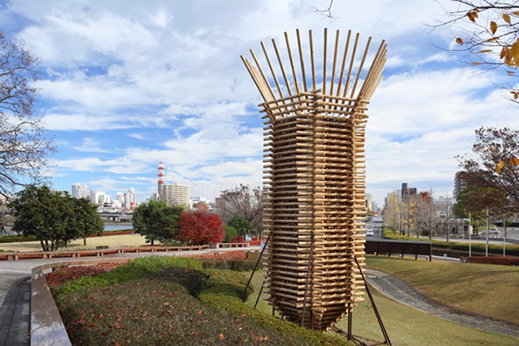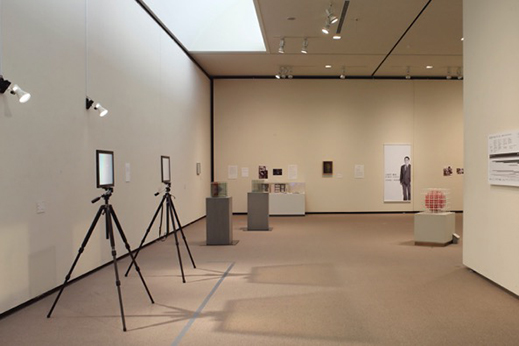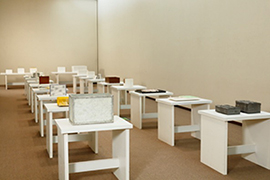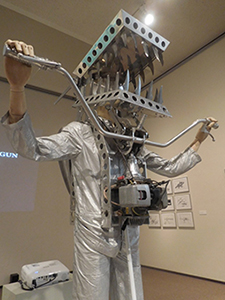 |
|
Here and There introduces art, artists, galleries and museums around Japan that non-Japanese readers and first-time visitors may find of particular interest. The writer claims no art expertise, just a subjective viewpoint acquired over many years' residence in Japan.
|
|
 |
|
|
 |
 |
Adventures in Art Education: The Avant-Garde Professors of Tsukuba
Alan Gleason |
 |
|
Yoichiro Kawaguchi's colorful "space crab" Cracco (2016, polyurethane, 8 x 4 x 6 meters) greets visitors in the lobby of the Museum of Modern Art, Ibaraki. |
Sixty kilometers northeast of Tokyo at the foot of Mt. Tsukuba sits Tsukuba Science City, a planned community built from scratch in the sixties to serve as a national research hub. There was once talk of moving the central government out of Tokyo into a new capital at Tsukuba, too; though this was not to be, the city has grown into a thriving mecca of academic and research institutions. One is the University of Tsukuba, which, in this sci-tech environment, would hardly seem fertile soil for one of Japan's most innovative and freethinking art education programs. But as a fascinating exhibition in nearby Mito demonstrates, the university is indeed just that.
Plastic Arts & Mixed Media, which runs until 29 January at the Museum of Modern Art, Ibaraki, takes its name from the University of Tsukuba course of study responsible for spawning an astonishing number of bright lights in Japan's contemporary art pantheon. Launched 40 years ago, the program went out of its way to recruit faculty who were themselves artists with a maverick streak; some had no previous academic background at all. With its motto of "any media, no rules," the curriculum they developed predictably met with raised eyebrows and not a few sneers from other departments, but today it is recognized as the nation's pioneer in the application of technology to creative expression via kinetics, electronics, computers, video, holography, and other media.
 |
|
Takamasa Kuniyasu's Rain-Collecting Tower stands outside the Museum of Modern Art, Ibaraki, with Lake Senba and the Mito skyline in the background. |
If Tsukuba appears an unlikely place for radical artistic experimentation, the presence of a modern art museum in Mito is equally unexpected. Ibaraki's prefectural capital is a conservative town, best known as a former bastion of Shogunate power during the Edo period and as home to one of Japan's three most celebrated landscape gardens, the Kairakuen. The museum, a prefectural institution, is a relatively recent arrival, having been built at the height of the country's economic bubble in 1988. An imposing structure whose bulk is mitigated by its park location next to lovely Lake Senba, it looks a bit intimidating as one approaches -- but hints abound that we are not in old Mito anymore. A trio of polyester-resin pigs frolics on the front lawn, and a primitive-looking wooden tower stands sentinel at the entrance.
The interior beckons with warm brownstone walls and a high-ceilinged, skylit entrance hall. Just when you're getting comfortable, however, you notice that a gargantuan rainbow-hued crab is staring balefully at you from across the lobby, daring you to proceed to the galleries upstairs. Once past the looming crustacean you encounter the work of four Tsukuba professors emeriti who were the driving forces behind the Plastic Arts & Mixed Media program's rise to notoriety. Each is accorded substantial floor space as well as a life-sized poster of the Sensei himself.
 |
|
Installation view, with Professor Mitamura's visage and works on display. |
Shunsuke Mitamura (b. 1936) appears to have pursued a lifelong fascination with art that is simultaneously two- and three-dimensional. He currently creates holograms, but among his most attractive works are objects made of multiple glass plates that produce illusions of 3D imagery, such as the sublime sphere of If the Moon Were a Mirror.
Katsuhiro Yamaguchi (b. 1928) is a pioneer in video art whose work brings to mind that of his famous contemporary, Nam June Paik. But he is also a maker of arresting sculptures like Bridge of May, a glowing fluorescent abstraction that dominates this section of the exhibition.
|
Shunsuke Mitamura's If the Moon Were a Mirror, composed of layers of double-sided mirrors (1968/2000, 30 x 30 x 30 cm). |
|
Katsuhiro Yamaguchi's light sculpture Bridge of May (1968, fluorescent lights and acrylic resin, 242 x 236.5 x 99.5 cm). |
Morio Shinoda (b. 1931) builds metal sculptures that prove, despite their cold materials and mechanistic titles, to be quite whimsical. TC6215 consists of a low table bedecked with numerous protuberances -- some phallic, some insect-like. What gives the work a quirky punch is the presence at one end of a foursome of perfectly sculpted piglets.
Of the four mentors, Tatsuo Kawaguchi (b. 1940) is the only one whose work directly references the university experience. A room devoted to his constructions is filled with row upon row of carefully assembled wooden boxes containing geometric arrays of bound sheaves of paper pierced with strands of wire. The materials, we learn, are actual relics of Kawaguchi's teaching career: textbooks, minutes of faculty meetings, encyclopedias (an entire set of which is encased in lead). For several years Kawaguchi was producing a new iteration in this series annually. What it says about his life in academia is not clear to me, but the studied repetition of materials with intriguing variations is almost musical in its development.
 |
|
 |
|
Tatsuo Kawaguchi's series of enigmatic boxes, Relation-Education/Educatio (1992-97, wood, copper, paper, brass). |
|
Morio Shinoda, TC6215 (1993, aluminum, stainless steel, brass, 200 x 100 x 80 cm). Photo by Kaoru Moriyama |
|
 |
|
|
|
Poodle's Head (2016, aluminum, engine) by Maywa Denki, who dons and operates the fearsome contraption in a hilarious video. Photo by Kaoru Moriyama
|
The four professors' oeuvres are impressive indeed, particularly considering that they made much of this seminal multimedia work in the late sixties and early seventies. But several of the most fully realized installations on show are recent efforts by their successors and students, which occupy a third gallery on the ground floor. Among the standouts are Yoton Ono, whose lifelike resin pigs loll about the gallery as well as on the front lawn; Maywa Denki, a creator of dadaistic devices whose Poodle's Head -- a vicious-looking engine-driven set of massive steel jaws with knives for fangs -- really does resemble a poodle with attitude; and Hideaki Sasaki, who has contributed the most serenely meditative work of the show with his Listening to Droplets, a roomful of ethereally lit receptacles into which water drips, unceasing yet barely audible.
|
Hideaki Sasaki's mystical Listening to Droplets (2016, water, light, glass containers, lamps). |
As this exhibition attests, the creative legacy of Tsukuba's black-sheep arts program is an awe-inspiring achievement, both in quality and reach. Ibaraki's Museum of Modern Art deserves kudos for bringing it to the attention of a broader public.
|
Yoton Ono's porcine presentation Warmth (2009, polyester resin, 80 x 50 x 60 cm each). Photo by Kaoru Moriyama |
All images courtesy of the Museum of Modern Art, Ibaraki;
photos by Sadamu Saito except where otherwise indicated. |
 |
|
| |
666-1 Higashi Kubo, Senba-cho, Mito City, Ibaraki Prefecture
Phone: 029-243-5111
Hours: 9:30 a.m. to 5 p.m.; closed Monday (or the following Tuesday when Monday is a national holiday)
Access: 15-minute walk or 5 minutes by bus from Mito Station on the JR Joban Line, 1 hour from Tokyo by limited express |
|
|
| |
 |
Alan Gleason
Alan Gleason is a translator, editor and writer based in Tokyo, where he has lived for 30 years. In addition to writing about the Japanese art scene he has edited and translated works on Japanese theater (from kabuki to the avant-garde) and music (both traditional and contemporary). |
|
|
|
|
|
|
|
|
|
 |
|